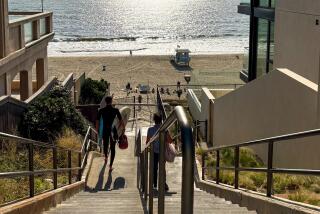Clipboard
âI donât know who he is, but I hope he doesnât mind the crumbs,â said the woman, brushing bread off the parkâs dedication plaque. She gathered up the remaining slice of day-old bread sheâd placed on the plaque overlooking a pond in Carl Thornton Park in Santa Ana. After pondering the image of Thornton cast in bronze, she said: âHe looks like a nice fellow.â
The air above her was filled with swirling and darting birds. âWhee, Nellie!â she shouted, tearing the bread into pieces and tossing it to a flock of mallards on the ground near her. âHere, duckies!â she said gleefully.
âHere come the honkers!â she shouted to her husband, who was tossing bread a few feet away. A gaggle of geese was making its way toward him through the fray. Their white feathers and bright orange bills stood out among the muted tones of the mallards. Among them was a mud hen or two. One of the geese approached cautiously, sticking his long neck toward an outstretched hand.
âWe come here every blessed day. We go around to the bakeries in the morning and get bread for my little pets,â she said.â
âHey, dad! Whatâs with them?â she shouted to her husband. The parkâs resident avians had been invaded by a flock of combative and aggressive sea gulls competing for the dayâs offering of food. âWhy are there so many?â she asked. âStorm coming,â replied her husband. âStorm coming, your grandmother!â she responded, dismissing his explanation.
âThose son of a guns. Look at them fighting each other! They should be at sea. The ducks used to be able to eat in peace,â she said, tossing bits of bread to the mallards. âCome on soldiers! Eat, eat, eat before the gulls come!â
The bread lady and her husband wouldnât give their names. But she said they lived in a nearby trailer park. âWeâre old ranch hands,â she said. âWe come here because it reminds us of home.â
Not too long ago, the bread lady was approached by a man who asked for some bread so he could feed the ducks too. âI turned around later and saw him eating it. You know, that man must have been starving. I will always share what I have with the poor,â she said.
Carl Thornton Park serves as the centerpiece for the surrounding neighborhood, which was built in the early 1970s. It was dedicated to Thornton, who foresaw the need for more open space while serving as city manager from 1951 to 1972, when the city was in the midst of rapid expansion. Thornton oversaw the construction of numerous parks, including the 30-acre site eventually named for him, in spite of his insistance that the only monument to him should be his years of service. When the park, designed by Ron Ono, was completed in 1985, it was declared Californiaâs best-designed neighborhood park by the California Parks and Recreation Society.
Steve Stricker, who works in an office nearby, comes to the park nearly every day around noon to eat lunch and watch the bread lady feed the birds. âI like to get away from the office for a while. Itâs good to have a change of atmosphere,â he said.
Nearby on the lawn, Bill Corbitt, who lives across the street, is attempting to cope with an active toddler and an infant. The toddler, wearing a âDonât Worry, Be Happyâ T-shirt, is crawling after the geese, determined to catch them. âI work the night shift, and my wife works during the day. So itâs my turn to baby-sit,â Corbitt said. âItâs good to take them out of the house to play. By the time they get back, theyâre ready for a nap and I can get some sleep too.â
Corbitt, who has lived in the neighborhood since 1974, said that when William Jr. and his brother, Vincent, get older, theyâll both attend nearby Thomas Jefferson Elementary School, on South Street. Later theyâll attend McFadden Intermediate School, next to the park.
Last year, McFadden was one of 25 schools in the nation designated as a National Distinguished School. In 1988, it was honored as a California State Distinguished School.
Dr. Joe Tafoya, of the Santa Ana Unified School District, said the school rates high because of strong parent involvement and a high-quality teaching staff. âThatâs what makes the neighborhood a great place to live. A good school is always central to a quality neighborhood,â he said.
Population: Total (1990 est.): 8,773 1980-90 change: +17.3% Median age: 32.1 Radical/ethnic mix: White (non-Latino): 51% Black: 5% Latino: 23% Other: 21% Income: Per capita: $20,900 Median household: $79,798 Average household: $81,126 Income distribution: $100,000-and more: 10% $75,000-99,999: 19% $50,000-74,999: 37% $25,000-49,999: 24% Less than $25,000: 10% By sex and age: in hundreds Males: Median age: 32.0 years Females: Median age: 32.1 years


